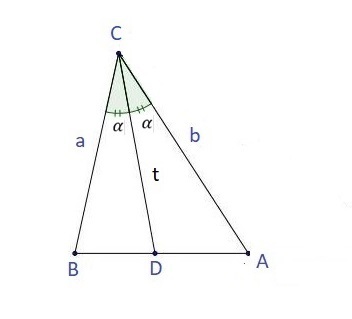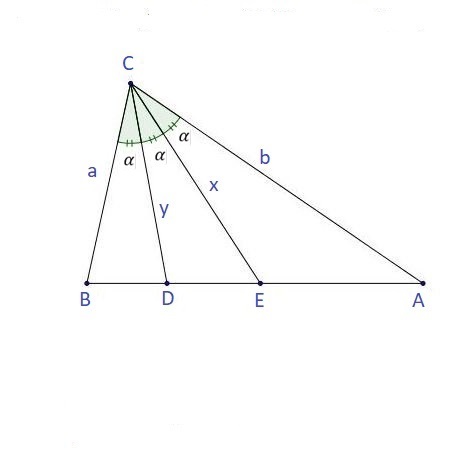Trisectors in a triangle
Triangle in the diagram above (not drawn to scale) has side lengths and with Line segments with length and with length trisect
Given that find the smallest value of such that to two decimal places.
The answer is 0.25.
This section requires Javascript.
You are seeing this because something didn't load right. We suggest you, (a) try
refreshing the page, (b) enabling javascript if it is disabled on your browser and,
finally, (c)
loading the
non-javascript version of this page
. We're sorry about the hassle.
First we are going to introduce a formula for the length of the bisector of a triangle in terms of the two sides forming the corresponding angle and the cosine of the half of the same angle.
Since the area of the triangle A B C is the sum of the areas of the two triangles B C D and A C D , then we have that 2 1 a t sin α + 2 1 t b sin α = 2 1 a b sin 2 α . Then using that sin 2 α = 2 sin α cos α and solving for t , we get that t = a + b 2 a b cos α . We can use this formula to express the x and y , using the triangles A C D and B C E , respectively (look at the figure below). So we get the following
y
=
a
+
x
2
a
x
cos
α
and
x
=
b
+
y
2
b
y
cos
α
.
Now, replacing in both equations the
y
by
3
2
x
,
we obtain the equations
3
2
x
=
a
+
x
2
a
x
cos
α
and
x
=
b
+
3
2
x
2
b
(
3
2
x
)
cos
α
.
So we get the following
y
=
a
+
x
2
a
x
cos
α
and
x
=
b
+
y
2
b
y
cos
α
.
Now, replacing in both equations the
y
by
3
2
x
,
we obtain the equations
3
2
x
=
a
+
x
2
a
x
cos
α
and
x
=
b
+
3
2
x
2
b
(
3
2
x
)
cos
α
.
Solving both equations for cos α , we get that cos α = 3 a a + x and cos α = 4 b 3 b + 2 x . ( ∗ ) Making the two expressions equal and solving for x we get that x = 4 b − 6 a 5 a b . Substituting the x by this expression in one of the equations of ( ∗ ) , we obtain that cos α = 4 b − 6 a 3 b − 2 a .
Of course, it is clear that α is an acute angle, and then 0 < 4 b − 6 a 3 b − 2 a < 1 . Since a < b , then 3 b − 2 a > 0 , and, therefore, 4 b − 6 a > 0 , because, otherwise, 4 b − 6 a 3 b − 2 a would not be positive. That is, the numerator and the denominator of the fraction 4 b − 6 a 3 b − 2 a are both positive. Now, we can see that if assume that 0 < 4 b − 6 a 3 b − 2 a ≤ 4 3 , then we obtain that 1 0 a ≤ 0 that is a contradiction. Assuming that 4 3 < 4 b − 6 a 3 b − 2 a < 1 , and solving both inequalities for b a , we obtain that 0 < b a and b a < 4 1 , respectively. The first of these two inequalities is always true, and the second tells us that the minimum value of k is less than or equal to 4 1 . Now we should prove that 4 1 is equal to the smallest value of k . Let us make s = 4 b − 6 a 3 b − 2 a . It is clear that s can made as close to 1 from below as you want. It is easy to get that b a = 6 s − 2 4 s − 3 that tends to 4 1 as s → 1 − . This proves that 4 1 is the smallest number k for which the inequality b a < k is always true for all possible values of a and b . Therefore, the answer for the question is 0 . 2 5